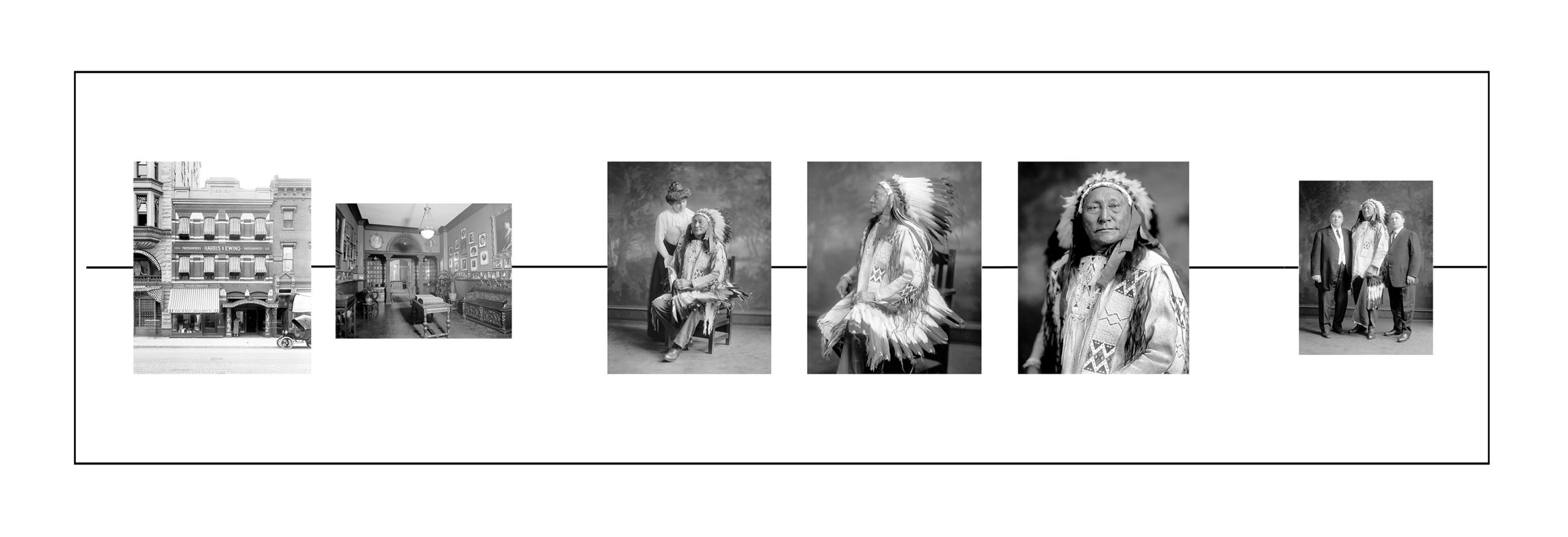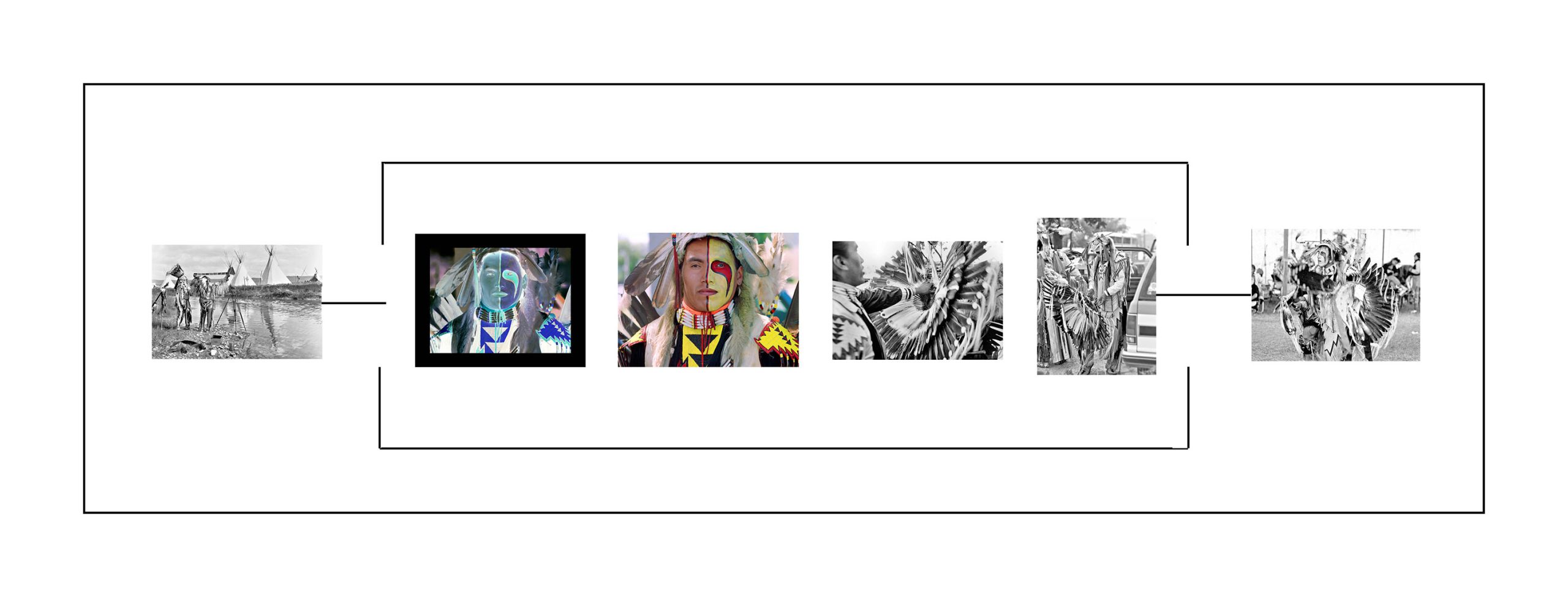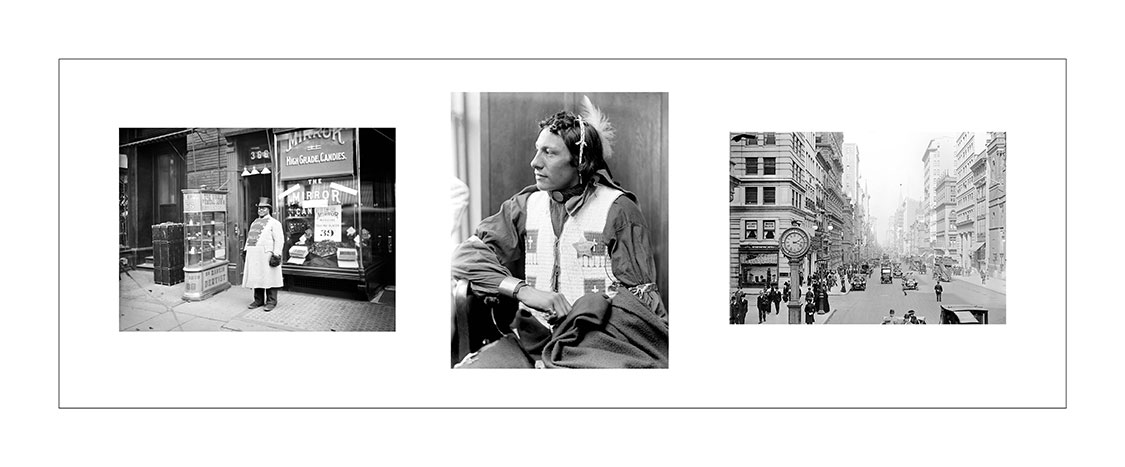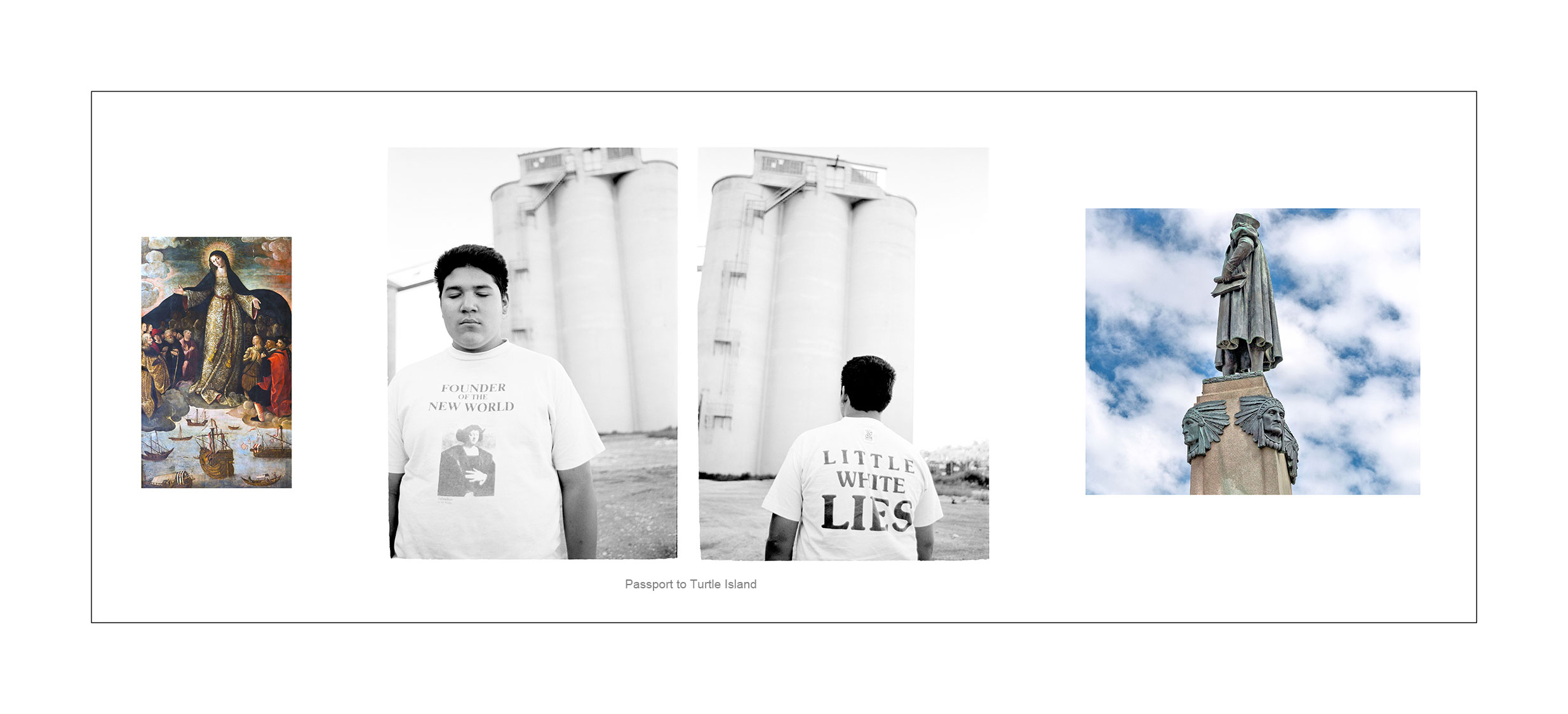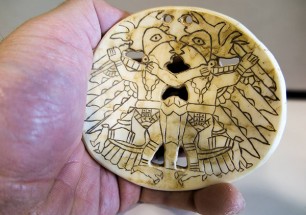Dream Panels
The image reminded me of something my elder said to me around the time I began university, she said, don’t forget where you come from. When I was younger, she had also said something to the effect that someday I would write my story. When I returned to Buffalo with my grandmother, I went to the corner where my friends hung out. There was no one around and it was a late summer night, the neighborhood was very quiet, and I sat on the steps of my grade school. Thinking about what my elder had said, I began to tell myself to remember everything to see, hear, and smell, this is who you are. I was a hybrid Iroquois teenager who was a first generation born and raised city Iroquois in my family. I began to make sure I didn’t forget anything of importance and started building my archive of memories. The 3D version of the Scout is symbolic of my journey, using my camera to study and understand the world around me. My website, jeff-thomas.ca, shows the results of my journey.
Panel 1. The Studio of Harris and Ewing, 1311-1313 F Street, N.W., Washington, D.C., GPS coordinates, 38.89752, -77.03031, pigment print on archival paper, 2023
In the studio with Hollow Horn Bear. I have seen many images during my research and the Library of Congress provided images that gave me some latitude in considering what the sitters, like Two Moons, would have seen. What did the interior of the studio look like? I find that this information expands upon Two Moons and to see him in the light of the day. Our visual memory usually presents the Indian as a typical stereotype, out of context from his home and his history. Two moons was a highly regarded leader of the Cheyenne.
KEY TO IMAGES (left to right)
Façade of the Harris & Ewing old studio, Courtesy of the Library of Congress Prints and Photographs Division Washington, D.C. 20540 USA, LC-H25- 23400-K.
Harris & Ewing studio waiting room, who was in the waiting room, waiting for their turn, between 1905 and 1945, Library of Congress Prints and Photographs Division Washington, D.C. 20540 USA, LC-DIG-hec-171
Hollow Horn Bear in the studio with studio assistant or photographer, Hollow Horn Bear is in partial tribal, warrior honor shirt, Headdress, cloth pants and leather shoes. He is posed before an outdoor backdrop, and a white woman, maybe a studio assistant, is standing over Hollow Horn Bear and looking down at him. Library of Congress Prints and Photographs Division Washington, D.C. 20540 USA, LC-DIG hec-17372
Hollow Horn Bear, directed to look to his side, displaying his long headdress. Library of Congress Prints and Photographs Division Washington, D.C. 20540 USA, LC-H25- 25409-L
Hollow Horn Bear, directed to look at the camera, 1905, Library of Congress Prints and Photographs Division Washington, D.C. 20540 USA, LC-H25- 25409-L
Hollow Horn Bear, posing with two unidentified white men in the studio, Library of Congress Prints and Photographs Division Washington, D.C. 20540 USA, LC-H25- 25409-A [P&P]
Hollow Horn Bear—Brulé, Curtis, Edward S., 1868-1952, photographer, c 1907 December 26. Published in: The North American Indian / Edward S. Curtis. [Seattle, Wash.] : Edward S. Curtis, 1907-30, Suppl., v. 3, pl. 82.), courtesy of the Library of Congress Prints and Photographs Division Washington, D.C., LC-USZ62-53674
Panel 2. Looking into the Future, pigment print on archival paper, 2023
I was intrigued by the historical photography showing two men from the Blackfoot tribe in Montana. They are dressed in tribal clothing and were subjects of a Curtis-like journey by Rodman Wannamaker, a businessmen who organized a United States allegiance tour in the West, often covering the same places that Curtis worked at. When I looked at the men, I imagined what it has been like for me, during my research and looking at glass plate negatives from the past. Today’s powwow dancers are a reminder that the drum never stopped beating and the people never stood still during the trying times they were subject to.
KEY TO IMAGES (left to right)
Two Blackfoot men in tribal clothing, looking at photographic film; they stand next to a stream with photographic equipment at their feet and tipis in the background. Montana. Dixon, Joseph Kossuth, photographer. Photograph taken during the Rodman Wanamaker Expedition, 1913. Courtesy of the Library of Congress Prints and Photographs Division Washington, D.C. Reproduction Number, LC- USZ62-53674
Note: The Camera is a Kodak 3A autographic camera available between 1903-1971 and shot Kodak 122 Large format size film. It was considered a “Post-Card format.”
Kevin Haywahe, Assiniboine First Nation, Carry The Kettle Reserve, Saskatchewan, portrait, negative version 1990, Winnipeg, intercity powwow, Manitoba
Kevin Haywahe, Assiniboine First Nation, Carry The Kettle Reserve, Saskatchewan, portrait, positive version, 1990, Winnipeg, Winnipeg, intercity powwow, Manitoba
Kevin Haywahe, Assiniboine First Nation, Carry The Kettle Reserve, Saskatchewan, preparing his dance bustle. 1990, Winnipeg, intercity powwow, Manitoba
Kevin Haywahe, Assiniboine First Nation, Carry The Kettle Reserve, Saskatchewan, tying his bustle to his lower back, 1990, Winnipeg, intercity powwow, Manitoba
Kevin Haywahe, Assiniboine First Nation, Carry The Kettle Reserve, Saskatchewan, dancing, 1990, Winnipeg, intercity powwow, Manitoba
Panel 3. Gertrude Käsebier’s studio window, pigment print on archival paper, 2023
Gertrude used the studio window light for lighting her Lakota sitters, it led me to wonder what they may have seen as they walked along the streets of New York City. The first time I was in Manhattan, I walked by a bookstore and saw a large book with Indians on the cover, I would come to know that it was made about Edward Curtis’s work. This was my first encounter with Curtis around the late 1970s.
KEY TO IMAGES (left to right)
A living sign on Fifth Avenue, New York City, New York City, 1900 Detroit Publishing Co., publisher, between 1900 and 1910. Library of Congress Prints and Photographs Division Washington, D.C., LC-DIG-det-4a27525
Käsebier, Gertrude, 1900, Unidentified Lakota performer in the Buffalo Bill show, wearing star-shaped badge reading: Buffalo Bill’s Wild West Co. Police. Courtesy of the Library of Congress Prints and Photographs Division Washington, D.C. 20540 USA, LC-DIG-ppmsca-12127
View of New York City, Fifth Avenue, Detroit Publishing Co., publisher, between 1900 and 1920. Library of Congress Prints and Photographs Division Washington, D.C. LC-DIG-det-4a27525
Panel 5. Seize the Space, pigment print on archival paper, 2023
KEY TO IMAGES (left to right)
Jeff Thomas, Indian Scout, circa 1996
Jeff Thomas, post removal of the Indian Scout, For Rent, 1999
Jeff Thomas, beginning of my new series, Seize the Space, with artist Greg Hill, 2000
Jeff Thomas, the Indian Scout’s canoe has arrived, canoe by Greg Hill, 2000
Jeff Thomas, Greg Hill with eagle feather, 2013
Panel 7. Doctrine of Discovery: Passport to Turtle Island, 2017/2023, pigment print on archival paper
Travelogue: The Doctrine of Discovery was promulgated by European monarchies in order to legitimize the colonization of lands outside of Europe. Between the mid-fifteenth century and the mid-twentieth century, this idea allowed European entities to seize lands inhabited by indigenous peoples under the guise of discovery. In 1494, the Treaty of Tordesillas declared that only non-Christian lands could be colonized under the Discovery Doctrine.
KEY TO IMAGES (left to right)
Alejo Fernández, Virgin of the Navigators, 1531–36, oil on panel (Reales Alcázares, Seville)
Jeff Thomas, Little White Lies, 1990, Winnipeg, Manitoba, GPS coordinates: 49.90391, -97.12856
Jeff Thomas, Christopher Columbus Monument, 2015, Syracuse, New York, GPS coordinates: 43.04683, -76.14911

